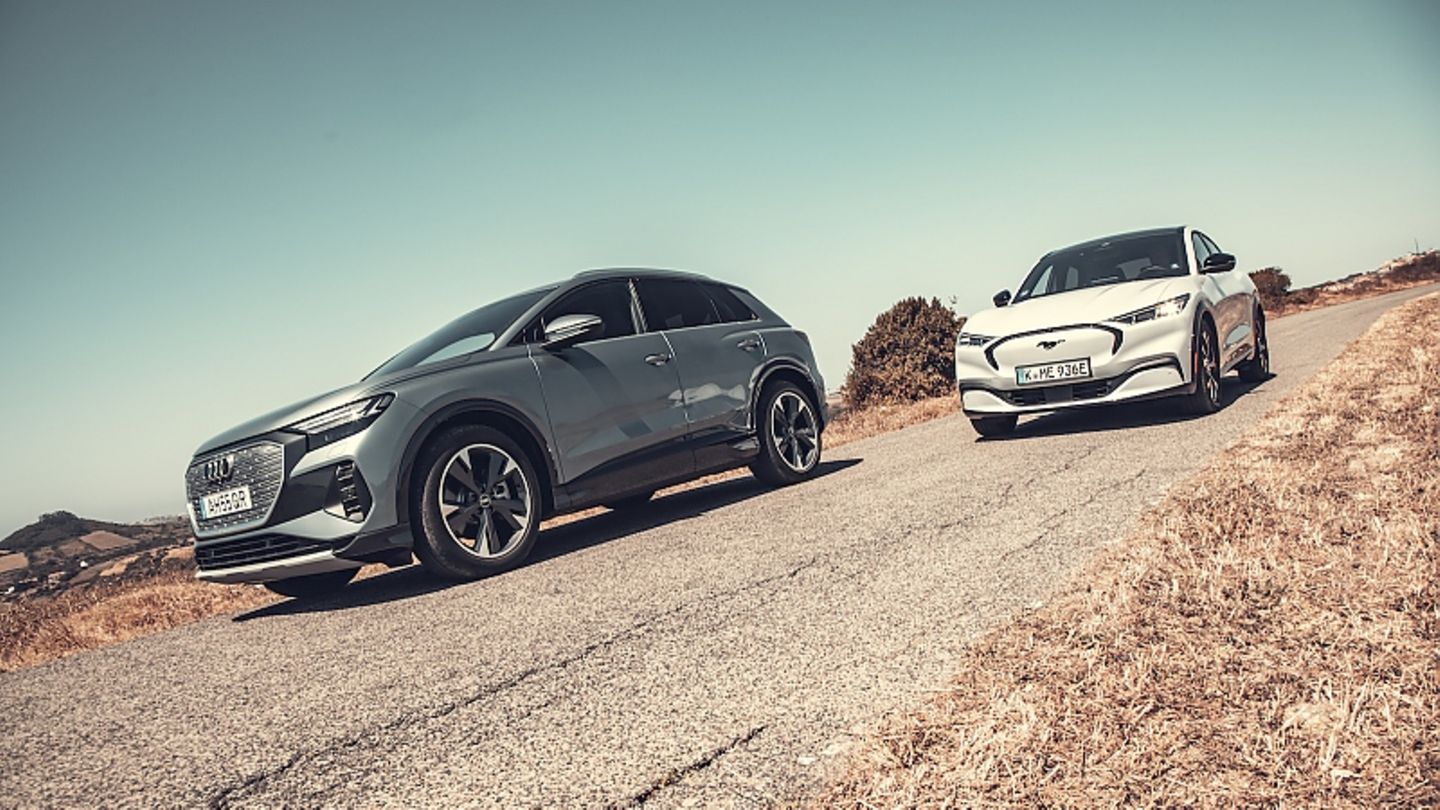The electric offensive in the auto industry is picking up speed and most of the spectacle can be expected with mid-range SUVs. There are two particularly interesting competitors here who attract family customers.
One thing may surprise you: in everyday life, the 258 kW / 351 PS strong Ford Mustang Mach-E, which has little in common with the legendary Mustang sports coupé except the name, does a lot more than the classy but reserved Audi Q4 with its 220 kW / 299 PS. The Ford is significantly larger (4.71 m, 13 cm longer than the Audi), the height is almost identical at almost 1.60 meters and the Mustang also has an increase of two centimeters in width. The Q4 offers four centimeters more ground clearance. What is really surprising is the big difference in the wheelbase, where the Ford offers 22 centimeters more.
We are therefore dealing with two SUVs that are perfect for four people and, to a limited extent, for five people, because although the rear passengers have less space, the lack of a cardan tunnel is pleasantly noticeable. The headroom is generous in both models, because even people who measure 1.90 meters can sit sensibly. With the help of a tape measure, we find that the Ford offers two centimeters more shoulder room at the front and rear with a similar height and the Audi with 81 four centimeters at the rear than the Mustang; quite a shock considering the Mustang is much longer between axles. And although much shorter: the Audi Q4 has a noticeably larger trunk with 520 versus 402 liters, which the American tries to compensate for with its front cargo space with a volume of 81 liters. Although this does not completely balance the total volume of the two loading compartments, it has functional advantages: While in the Audi you have to remove all suitcases to access the charging cables under the trunk floor, in the Mach-E it is sufficient to open the bonnet.
Unsurprisingly, the dashboard of the Audi is much more elegant and chic than that of the Ford Mach-E. With the Ford, it looks like someone screwed a giant tablet into the center of the dash and ran out of budget to develop a full instrument panel. With the Q4, the driver feels more involved because the central 10.25-inch display is inclined towards him, while the Mustang’s 15-inch screen is positioned neutrally in the middle. In the Q4, the controls for the air conditioning are located below this screen and below, between the two seats, there is an open area in which the selector switch for the driving mode and the gear shift as well as the volume are located. Behind the Mustang rudder there is a narrow and hardly configurable digital instrumentation, which changes its appearance depending on the selected driving mode. However, there is no individual mode that allows you to configure various settings within the individual modes (e.g. sport steering with comfortable suspension) and it is not possible to visualize the amount of energy recovered during braking. In addition, the Audi Q4 is characterized by its advanced head-up display with augmented reality details that the American competitor does not even offer for a surcharge.
Both electric SUVs accelerate more than impressively, but the top speed of both competitors is limited to 180 km / h. Much more impressive is the image sprint from 0 to 100 km / h, which the Audi (460 Nm maximum torque) does in 6.7 seconds and the Mach-E, thanks to 580 Nm, in an excellent 5.1 seconds. The all-wheel drive in each case plays a significant role in the fact that the two 2.2-ton all-wheel-drive SUVs convert their engine power into propulsion as befits their standing.
The position and weight of the batteries between the drive axles make a significant contribution to improving dynamic stability by lowering the center of gravity and at the same time contributing to a very balanced mass distribution. However, that does not change the fact that you cannot feel the very high vehicle weight. Only some of this can be played over by the adaptive electronic dampers, which the Ford, unlike the Audi, will only offer in its upcoming GT top version. Both competitors have independent wheel suspensions on all four wheels (including multi-link rear) and discreetly push uneven floors into the background without being spongy or even soft. With its lower ground clearance (14.5 compared to 18 centimeters for the Audi), the Mustang has greater stability, especially in the border areas, which is not least due to the lower center of gravity and the greater width. While the Mustang Mach-E rolls on 225/55 R19 tires, the Audi offers mixed wheels with better driving dynamics (235/50 R20 at the front and 255/45 R20 at the rear).
These are differences that the driver can feel at the wheel. The Audi steering is more precise and communicative, while the Ford handlebar feels more synthetic, even when you switch to Untamed driving mode. Speaking of which, the driving modes are more differentiated in the Mustang, but there is no display in the dashboard about the selected mode, while the Q4 shows which mode has been selected. In both models, the torque output varies depending on the selected mode, with more power being sent to the rear wheels in the sportier programs, supported by a torque vectoring effect through selective braking interventions, which ultimately support the steering and reduce the tendency to understeer. The Mach-E can be moved much more sportily when you are out and about in Untamed mode. Prepare for some fun moments where the heck gets cocky when provoked. As mentioned, the F351 PS strong Ford has three energy recovery levels, the strongest of which enables the one-pedal feeling and you can almost forget the left pedal. The individual recuperation levels are defined via the central display, where the electronic simulation of the sound of a gasoline engine can also be set. The Audi Q4 also offers three modes, one for single-pedal operation, which can be selected using the shift paddles mounted on the steering wheel, which creates an effect similar to that of the gear reduction in a sporty driving style.
In a comparison test, the two current top models compete against each other, which offer more power and more range. With its larger battery (88 versus 77 kWh) it is not surprising that the Mustang can cover more kilometers on a full charge: 540 kilometers are officially promised (486 in the case of the Audi), but in this test the proven distances were shorter. The Ford 460 made it, while the Audi Q4 had to go back to the charging station after 383 kilometers. The Mustang can refuel with up to 150 kilowatts at a fast charging station, while the Q4 E-Tron cannot exceed 125 kW. With alternating current, the maximum output is the same for both models (eleven kilowatts three-phase / seven kilowatts single-phase). With direct current, ten minutes with the respective maximum currents is sufficient to increase the range of the Audi to 130 kilometers and that of the Ford to 119 kilometers. With normal AC charging with eleven kilowatts, it takes more than seven / eight hours for a full charge in both cases.
The entry-level price of the Audi Q4 e-tron 50 quattro (200 kW / 299 PS for 53,600 euros) is significantly lower than that of the Ford Mustang Mach-E AWD Extended Range (258 kW / 351 PS for 63,700), which ultimately makes this comparison test its Favor decides. Although the standard equipment of the Ingolstadt-based driver leaves painful gaps that the Ford Mustang Mach-E already offers ex works, the American cannot fully implement its performance advantage. The Ford shines with more range and a faster charge, slightly better driving performance and a sporty aesthetic. The Audi is hardly slower and scores with its advanced interior, better workmanship and a slightly more spacious cabin – for significantly less money.
I am a 24-year-old writer and journalist who has been working in the news industry for the past two years. I write primarily about market news, so if you’re looking for insights into what’s going on in the stock market or economic indicators, you’ve come to the right place. I also dabble in writing articles on lifestyle trends and pop culture news.




